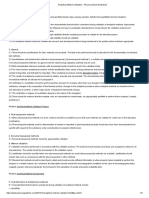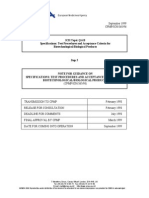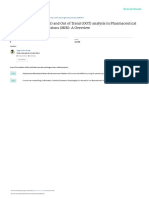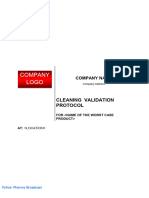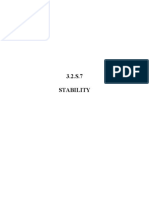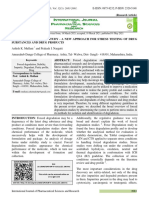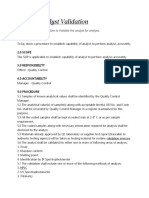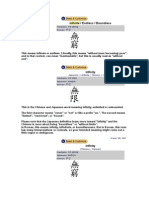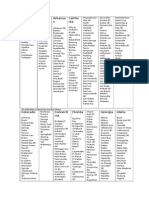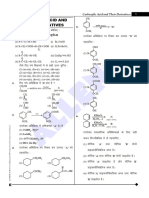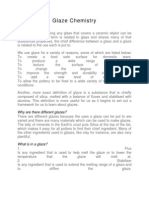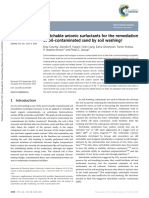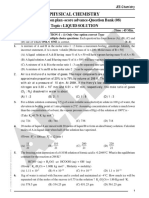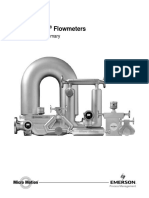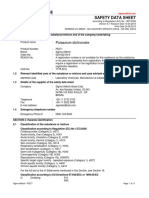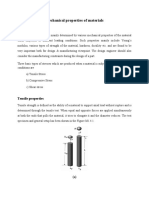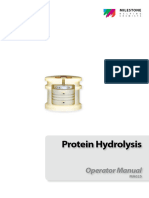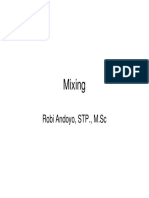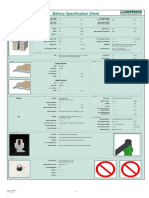Handling and Working With Analytical Standards
Handling and Working With Analytical Standards
Uploaded by
PreuzCopyright:
Available Formats
Handling and Working With Analytical Standards
Handling and Working With Analytical Standards
Uploaded by
PreuzCopyright
Available Formats
Share this document
Did you find this document useful?
Is this content inappropriate?
Copyright:
Available Formats
Handling and Working With Analytical Standards
Handling and Working With Analytical Standards
Uploaded by
PreuzCopyright:
Available Formats
SOP # A-305-01-060Y
STANDARD OPERATING PROCEDURES
Page: 1 of 6
Handling and working with Analytical Standards
1.Purpose
The purpose of this Standard Operating Procedure is to establish a standardized procedure of using United States Pharmacopoeia (USP) standards, detailing the procedure of qualification, storage, handling and use of working standards and impurity standards.
2. Responsibility
2.1 The responsible person in charge of standards is to keep effective standards only, and to ensure compliance with this SOP. 2.2 All analysts shall follow these procedures. 2.3 Laboratory and project managers shall verify compliance with this SOP.
3. Frequency
Whenever a new working or impurity standard is introduced.
4. Procedure
4.1 Qualification and Characterization of Working Standards 4.1.1 Raw materials that have been received and released for manufacturing are used as working standards. Plant analytical laboratories acquire raw materials via the Production Planning department. The current lot of raw materials is to be sampled. 4.1.2 The material being tested is analyzed according to Pharmacopeial or Primary standards (if it is not a Pharmacopeial product). Full Pharmacopeial monograph testing of the proposed material must be performed. The material must conform to all monograph limits when used as a working standard. 4.1.3 Qualification of working standards (I) against valid working standards (II) may be performed only in the event that the batch used for working standards (II) has not expired (based on available stability data). 4.2 Purity/Potency Determination 4.2.1 The degree of potency is to be established by chromatographic validated method. If the monograph contains only one method for assay (without purity determination), it is preferable to use a stability indicating method of the drug substance for purity determination. The results are be recorded and/or regarded as chromatographic purity.
Laboratory Handbook of Pharmaceutical Generic Development
ED. N0: NEW Ed. Status : ORIGINAL
Effective Date:
APPROVED:
http://www.iagim.org
QC QA info@locumUSA.com HEAD 24 Volume Series
DD / MM / 200Y
SOP # A-305-01-060Y
STANDARD OPERATING PROCEDURES
Page: 2 of 6
Handling and working with Analytical Standards
4.2.2 If no drying is required, the assay and the water determination may be analyzed individually and the assay recorded "as is". The assay refers to the declared amount, and the figure is to be used in calculating the results of the assay. The standard potency is calculated as follows: In the event of assay determination on dry basis: Potency = % Assay 100 - moisture %
In the event of chromatographic purity determination:
Chromatographic purity (by area) = (100 - moisture %) 100 4.2.3 A notation concerning the purity value to be used is to be specified in the COAs. 4.3 Storage Working standards are stored in the same manner as indicated by the corresponding primary / pharmacopoeia standards. 4.3.1 Working standards are stored in amber glass containers, protected from light, heat and moisture. 4.3.2 Working standards should be kept at ambient conditions in an amber dissector cabinet, unless otherwise specified by the individual monograph. 4.3.3 Standards that require storage in a "cold" or "dry" place are to be stored in a refrigerator at 2-8C. 4.4 Handling 4.4.1 Working and impurity standards are recorded in the Working Standards file after having been assayed for potency. All standards must be provided with COA. 4.4.2 At the time of use, the analyst is to ensure that the standard has not expired. The analyst will keep the standard out of the storage for as short a time as possible to prevent light and moisture from affecting the standard. When storing the standard in a cool place, equilibrate it to room temperature. After use, any unused standard may be discarded.
Laboratory Handbook of Pharmaceutical Generic Development
ED. N0: NEW Ed. Status : ORIGINAL
Effective Date:
APPROVED:
http://www.iagim.org
QC QA info@locumUSA.com HEAD 24 Volume Series
DD / MM / 200Y
SOP # A-305-01-060Y
STANDARD OPERATING PROCEDURES
Page: 3 of 6
Handling and working with Analytical Standards
4.4.3 After the analyst has used up the standard, it is to be returned to the appropriate storage location. 4.5 Drying 4.5.1 Working standards are to be dried in accordance with the labeling of the same Pharmacopeial or primary standard. 4.5.2 If a standard requires drying, the required amount must be transferred to a clean weighing bottle for drying. The weighing bottle must be protected from light during use. Dried standards must not be returned to the original bottle in order to avoid any possible contamination of the stock. 4.5.3 After drying, place the standard into the desiccator to equilibrate before assaying. 4.6 Expiry Date and Retest 4.6.1 The expiry date of the working standards is 2 years from the date of the potency/purity determination. The re-assay process may be performed one month prior to or after the expiry date. 4.6.2 The retesting of a previously used batch/lot only entails re-assay for potency/purity vs. Pharmacopeial or primary standards by the HPLC method (stability indicating method) and water determination. 4.6.3 The expiry date period is to be extended to 1 year, unless the material is considered a highly sensitive substance, in which case, the expiry date period is to be shortened. Only two additional extensions may be performed. 4.6.4 In all cases of retesting, the expiry date may not pass the original expiry date determined by the manufacturer. 4.6.5 Impurity standards are used for qualitative purposes only, and their expiry date cannot be specified. The expiry date is determined within 2 years from the day of receipt.
Laboratory Handbook of Pharmaceutical Generic Development
ED. N0: NEW Ed. Status : ORIGINAL
Effective Date:
APPROVED:
http://www.iagim.org
QC QA info@locumUSA.com HEAD 24 Volume Series
DD / MM / 200Y
SOP # A-305-01-060Y
STANDARD OPERATING PROCEDURES
Page: 4 of 6
Handling and working with Analytical Standards
4.7 Labeling 4.7.1 The working standard bottles contain the following details: Name Stock no. Catalog no. Expiry date Purity % (as is) Water % Storage conditions (if special conditions are required) Special care before use (e.g. drying, water determination)
* If the material is hygroscopic, extra precautions are required when drying the sample prior to use.
5. Limits/Limitations
5.1 Impurity standards for qualitative analysis must be identified either on the basis of the supplier certificate of analysis, or by a specific method. 5.2 Ensure that the method used for purity determination is a fully validated stability indicating method. 5.3 In the event that the obtained purity result exceeds 100.0%, the purity value will be considered 100.0%. 5.4 In the event that the obtained water determination result is less than 0.1%, the result will be considered 0.0%.
6. Corrective Action
None.
7. Documentation
7.1 List of all the working standards defined by the respective codes and analysis numbers must be documented. The following information is to be recorded for every standard: Catalog no., name, lot no., expiry date, purity %, water, retest date, special care (if required, e.g. drying, water determination), name and number of the reference standard lot used to qualify the standards and Certificates of Analysis. 7.2 The expiry date and retest month must be specified in the COA working standards in addition to the other details.
ED. N0: NEW Ed. Status : ORIGINAL Effective Date:
APPROVED:
http://www.iagim.org
QC QA info@locumUSA.com HEAD 24 Volume Series
DD / MM / 200Y
Laboratory Handbook of Pharmaceutical Generic Development
SOP # A-305-01-060Y
STANDARD OPERATING PROCEDURES
Page: 5 of 6
Handling and working with Analytical Standards
Appendix - 01/00
Schematic Diagram Reference Standards
Reference Standards
Primary Standards
Pharmacopeial standards Source: Pharmacopeia Commision
Primary Standards Source: Suppliers
Working Standards
Impurity Standards
Laboratory Handbook of Pharmaceutical Generic Development
ED. N0: NEW Ed. Status : ORIGINAL
Effective Date:
APPROVED:
http://www.iagim.org
QC QA info@locumUSA.com HEAD 24 Volume Series
DD / MM / 200Y
SOP # A-305-01-060Y
STANDARD OPERATING PROCEDURES
Page: 6 of 6
Handling and working with Analytical Standards
Appendix (Cont.)
Reference Standards are characterized according to the intended use as follows:
Primary Standard
Materials which are accepted without reference to other standards. If the materials have undergone complete analytical characterization, their identity must be proven (elucidation of chemical structure) and their purity must be sufficiently high and stated (>99.0%). The characterization of primary standards generally involves the elucidation of: Chemical structure such as; IR, UV, H-NMR, C-NMR, MS, CD etc. Purity determination such as. HPLC, TLC, GC, GPC, DSC, residue of ignition, water content etc. Assay: Titration, DSC, Chromatography. It is acceptable that the manufacturing process of primary references standards differs from the final processing of the drug substance. In all cases, the analytical procedure (purity and assay) used for characterization must be validated.
Pharmacopeial Standards
Commonly used for certain tests and assayed to achieve accuracy and precision of analytical results required in compendia monographs. It may be used only for the purpose for which it is intended. Note: Pharmacopeial standards are basically regarded as primary standards. However, according to the laboratories requirements they are considered a different category. All standards are reference standards.
Working Standards
Materials are designed for daily use in instrumental analysis such as routine quality control. They are characterized by comparison with Primary or Pharmacopoeia standards. Their purity corresponds to a "typical batch". Impurity Standards Materials are designed for use in qualitative tests only. They are mainly required for development and validation of analytical procedures (e.g. specificity, Detection Limit (DL) and Quantitation Limit (QL), compared to drug substance etc.). For routine controls, the impurity standards are not generally needed.
3
[End of Document]
Laboratory Handbook of Pharmaceutical Generic Development
ED. N0: NEW Ed. Status : ORIGINAL
Effective Date:
APPROVED:
http://www.iagim.org
QC QA info@locumUSA.com HEAD 24 Volume Series
DD / MM / 200Y
You might also like
- QCD-036-01 Good Chromatography PracticesDocument12 pagesQCD-036-01 Good Chromatography Practicesarnab rayNo ratings yet
- SOP For Analytical Method VerificationDocument6 pagesSOP For Analytical Method VerificationMubarak Patel100% (2)
- Challenges in Analytical Method Development ForDocument3 pagesChallenges in Analytical Method Development ForTanuja Pathare100% (1)
- Analytical Method Validation - Pharmaceutical GuidelinesDocument3 pagesAnalytical Method Validation - Pharmaceutical GuidelinesMSL India100% (1)
- ICH Quality Guidelines: An Implementation GuideFrom EverandICH Quality Guidelines: An Implementation GuideAndrew TeasdaleNo ratings yet
- Practical Approaches to Method Validation and Essential Instrument QualificationFrom EverandPractical Approaches to Method Validation and Essential Instrument QualificationNo ratings yet
- Method Transfer SopDocument10 pagesMethod Transfer Sopprecisionlaboratory240% (1)
- Methods For Identifying Out of Trends in Ongoing StabilityDocument10 pagesMethods For Identifying Out of Trends in Ongoing StabilityPiruzi MaghlakelidzeNo ratings yet
- Good Chromatography Practices - SOP & Guideline - Pharma BeginnersDocument46 pagesGood Chromatography Practices - SOP & Guideline - Pharma BeginnersSAISIVARAMAKRISHNA KATTULA100% (1)
- GMPs Workshop - Analytical Method Validation (Regulatory Perspective - Linda NG, FDA)Document31 pagesGMPs Workshop - Analytical Method Validation (Regulatory Perspective - Linda NG, FDA)Helena DordioNo ratings yet
- J. System Suitability Specifications and TestsDocument7 pagesJ. System Suitability Specifications and Testsjljimenez1969No ratings yet
- Analyst Qualification (Modified)Document6 pagesAnalyst Qualification (Modified)vasant ugale75% (4)
- HPLC Column Cleaning and RegenerationDocument2 pagesHPLC Column Cleaning and RegenerationOrc Phar100% (1)
- Assay and Dissolution EtoricoxibDocument8 pagesAssay and Dissolution Etoricoxibsesilia dyah novitrianiNo ratings yet
- TOC Cleaning ValidationDocument6 pagesTOC Cleaning Validationjljimenez1969100% (1)
- SOP For Reduce Testing For Raw MaterialDocument3 pagesSOP For Reduce Testing For Raw MaterialMubarak Patel67% (3)
- HPLC Troubleshooting E-BookDocument19 pagesHPLC Troubleshooting E-BookFajarNo ratings yet
- Paracetamol & Ibuprofen SuspensionDocument3 pagesParacetamol & Ibuprofen SuspensionAmik TuladharNo ratings yet
- Ongoing Stability Testing Requirements, Solutions and Potential PitfallsDocument3 pagesOngoing Stability Testing Requirements, Solutions and Potential PitfallssamxuNo ratings yet
- ICH Topic Q 6 BDocument17 pagesICH Topic Q 6 BAprianaRohmanNo ratings yet
- Analytical Method ValidationDocument16 pagesAnalytical Method ValidationBRIJENDRA KUMAR SINGHNo ratings yet
- SOP For Washing of HPLC ColumnsDocument2 pagesSOP For Washing of HPLC Columnsziaddd100% (2)
- Understanding API Assay, Potency, and PurityDocument17 pagesUnderstanding API Assay, Potency, and PurityAngel Flores100% (1)
- CTD Open CefoperazoneDocument83 pagesCTD Open CefoperazoneSarfarazpk1100% (1)
- Analytical Method EquivalencyDocument9 pagesAnalytical Method EquivalencySrinivas Reddy MaramNo ratings yet
- Evaluation of Stability DataDocument21 pagesEvaluation of Stability DataMartin Celestino100% (2)
- Out of Specification (OOS) and Out of Trend (OOT) Analysis in Pharmaceutical Manufacturing Investigations (MIR) : A OverviewDocument9 pagesOut of Specification (OOS) and Out of Trend (OOT) Analysis in Pharmaceutical Manufacturing Investigations (MIR) : A OverviewDHiana100% (2)
- HPLC Column UsageDocument11 pagesHPLC Column Usagenetelsrt1298No ratings yet
- ASEAN Guideline On Process Validation - Q& ADocument3 pagesASEAN Guideline On Process Validation - Q& AMuqeet KazmiNo ratings yet
- HPLC Problems-1Document15 pagesHPLC Problems-1sanihgholiyah100% (1)
- QBD Approach To Assay Development and Method Validation 11052014Document9 pagesQBD Approach To Assay Development and Method Validation 11052014Prashansa Shrestha100% (1)
- Validation-An Important Tool of GMP: About Authors: Karmveer TomarDocument4 pagesValidation-An Important Tool of GMP: About Authors: Karmveer TomarShiv KumarNo ratings yet
- RM-Method Validation ProtocolDocument12 pagesRM-Method Validation ProtocolShagorShagorNo ratings yet
- Validation - VerificationDocument51 pagesValidation - VerificationAldafa FebbyantNo ratings yet
- Cleaning Validation Protocol 1711193154Document17 pagesCleaning Validation Protocol 1711193154P SRINIVAS RAONo ratings yet
- Jabed Process ValidationDocument8 pagesJabed Process Validationjabed sarkarNo ratings yet
- Endotoxin Test Protocol PTSDocument5 pagesEndotoxin Test Protocol PTSSebastián SalazarNo ratings yet
- How To Validate Analytical MethodsDocument9 pagesHow To Validate Analytical MethodsFernando Silva BetimNo ratings yet
- Stability Data - ConcordDocument127 pagesStability Data - Concordтатьяна васильковаNo ratings yet
- Dissolution Case StudiesDocument70 pagesDissolution Case Studieslhthang1990100% (1)
- Omgoing Stability Testing - Innovations - in - Pharmaceutical - TechnologyDocument3 pagesOmgoing Stability Testing - Innovations - in - Pharmaceutical - TechnologyJuan RojasNo ratings yet
- Care Maintenance and HPLC Column TroubleshootingDocument52 pagesCare Maintenance and HPLC Column TroubleshootingducngoctrinhNo ratings yet
- 2 Process Validation QandA Version 4 (June 2011) - Adopted 18th PPWG Meeting PDFDocument4 pages2 Process Validation QandA Version 4 (June 2011) - Adopted 18th PPWG Meeting PDFVishal SomaniNo ratings yet
- Stress Testing - Forced DegradationDocument9 pagesStress Testing - Forced DegradationMr. HIMANSHU PALIWALNo ratings yet
- Good Chromatographic PracticesDocument59 pagesGood Chromatographic PracticesSathish VemulaNo ratings yet
- Parameters of Method Development (Using HPLC)Document21 pagesParameters of Method Development (Using HPLC)Nikita SinghNo ratings yet
- Finished Pharmaceutical Product Specifications: Rutendo KuwanaDocument17 pagesFinished Pharmaceutical Product Specifications: Rutendo KuwanaStuNo ratings yet
- Meclizine HCLDocument10 pagesMeclizine HCLChEng_No ratings yet
- SOP For Analyst ValidationDocument5 pagesSOP For Analyst ValidationGencay Ergin100% (1)
- Purified Water - British PharmacopoeiaDocument4 pagesPurified Water - British PharmacopoeiamariashidalgoNo ratings yet
- Chlorhexidine Gluconate Scrub Solution - ProtocolDocument16 pagesChlorhexidine Gluconate Scrub Solution - ProtocolMy bookNo ratings yet
- Quality Control Review ArticleDocument18 pagesQuality Control Review ArticleMukesh Tiwari100% (2)
- MICRO 4 SOP For Microbial Monitoring in Drain Point of Pharmaceutical Manufacturing SitesDocument2 pagesMICRO 4 SOP For Microbial Monitoring in Drain Point of Pharmaceutical Manufacturing SitesAjesh Tk100% (1)
- Assay by Titration Validation Protocol-ModelDocument9 pagesAssay by Titration Validation Protocol-ModelAnzari Muhammad100% (4)
- Good Chromatographic Practices SopDocument2 pagesGood Chromatographic Practices SopJason0% (2)
- Corey Prostaglandin SynthesisDocument12 pagesCorey Prostaglandin SynthesisPreuzNo ratings yet
- Kanjis-From Orientaloutpost and StockkanjiDocument39 pagesKanjis-From Orientaloutpost and StockkanjiPreuzNo ratings yet
- Greyhound-BusStops Cities TableDocument9 pagesGreyhound-BusStops Cities TablePreuzNo ratings yet
- How To Expand Your DnaDocument5 pagesHow To Expand Your DnaPreuz100% (2)
- Chaos Before CreationDocument13 pagesChaos Before CreationPreuzNo ratings yet
- Bacterial Wilt - Culture Media of Ralstonia Solanacearum - 2Document9 pagesBacterial Wilt - Culture Media of Ralstonia Solanacearum - 2PreuzNo ratings yet
- Risk Cube Method To Derive Cost RiskDocument4 pagesRisk Cube Method To Derive Cost RiskPreuzNo ratings yet
- 22 2 Temperature-Programmed TechniquesDocument1 page22 2 Temperature-Programmed TechniquesBrayan UribeNo ratings yet
- Carboxylic Acid and Their DerivativesDocument5 pagesCarboxylic Acid and Their DerivativesShubham KumarNo ratings yet
- Glaze ChemistryDocument9 pagesGlaze ChemistrydtkraeutNo ratings yet
- Operation Manual of CHANGHONG Ni-Fe CellDocument7 pagesOperation Manual of CHANGHONG Ni-Fe CellAndrewSpeedyFeetNo ratings yet
- Switchable Anionic Surfactants For The Remediation of Oil-Contaminated Sand by Soil WashingDocument8 pagesSwitchable Anionic Surfactants For The Remediation of Oil-Contaminated Sand by Soil WashingMónica Tatiana HerreraNo ratings yet
- ScrubberDocument12 pagesScrubberDiego Silvano J. Barros100% (1)
- Aakash JeeDocument2 pagesAakash JeeryreddyNo ratings yet
- 08-Liquid Solution - EngDocument5 pages08-Liquid Solution - EngMr XNo ratings yet
- SO2 at Exit-Ppm To KGDocument5 pagesSO2 at Exit-Ppm To KGAnil Kumar SinghNo ratings yet
- 10 - Beer's Law TartrazineDocument4 pages10 - Beer's Law Tartrazineomar0% (1)
- Micro Motion Flowmeters: Specifications SummaryDocument20 pagesMicro Motion Flowmeters: Specifications SummaryJoaquim SantosNo ratings yet
- R060 - Dicromato Potassio (Padrao Primario) - SigmaDocument9 pagesR060 - Dicromato Potassio (Padrao Primario) - SigmalilazzariNo ratings yet
- Biomaterial Research JapanDocument69 pagesBiomaterial Research JapanJeremy BellNo ratings yet
- Reinforced Concrete Lecture Notes University of HongKongDocument32 pagesReinforced Concrete Lecture Notes University of HongKongApril Ingram100% (4)
- 25-Shell Helix HX3 20W-50Document1 page25-Shell Helix HX3 20W-50Kareem HussainNo ratings yet
- SRS (Sulphate Removal System) - Brine Electrolysis - ThyssenKrupp Uhde Chlorine Engineers (Japan) LTDDocument2 pagesSRS (Sulphate Removal System) - Brine Electrolysis - ThyssenKrupp Uhde Chlorine Engineers (Japan) LTDpetros222No ratings yet
- Mechanical Properties of MaterialsDocument11 pagesMechanical Properties of MaterialsThiru MoorthyNo ratings yet
- MA025-005 Protein HydrolysisDocument27 pagesMA025-005 Protein HydrolysisMichael MichaelidesNo ratings yet
- Material Safety Data Sheet: Boiler CoagulantDocument5 pagesMaterial Safety Data Sheet: Boiler CoagulantJezrell JaravataNo ratings yet
- Iso 9686 2006Document11 pagesIso 9686 2006Airin AnnisaNo ratings yet
- What Is Atomic Absorption Spectroscopy?: Atomization System, The Monochromator and The Detection System (Figure 1)Document3 pagesWhat Is Atomic Absorption Spectroscopy?: Atomization System, The Monochromator and The Detection System (Figure 1)Belal FatahNo ratings yet
- Kinetics of Chemical Reactions in FoodsDocument44 pagesKinetics of Chemical Reactions in FoodsSolomon Gebremariam100% (1)
- Capacitive TransducersDocument5 pagesCapacitive TransducersKhairunnisa Abu KhairNo ratings yet
- Mixing (Compatibility Mode)Document18 pagesMixing (Compatibility Mode)singgih candra prayogaNo ratings yet
- Separation of Uracil, Benzene, Toluene and Ethylbenzene Using HPLCDocument11 pagesSeparation of Uracil, Benzene, Toluene and Ethylbenzene Using HPLCNolzConxNo ratings yet
- Presented By: Submitted To:: Dr. Rakesh SohalDocument10 pagesPresented By: Submitted To:: Dr. Rakesh SohalAnonymous LeQnwAFqNo ratings yet
- FormulationDocument5 pagesFormulationHafiz Muhammad YousafNo ratings yet
- Technical - Datasheet - Grid Power VRX-FT 12-180Document1 pageTechnical - Datasheet - Grid Power VRX-FT 12-180xuyen tranNo ratings yet
- Omega 99Document3 pagesOmega 99Badeng LawotNo ratings yet
- Cold Facts Vol 33 No 3 (2017)Document48 pagesCold Facts Vol 33 No 3 (2017)Binh Thanh LeNo ratings yet



